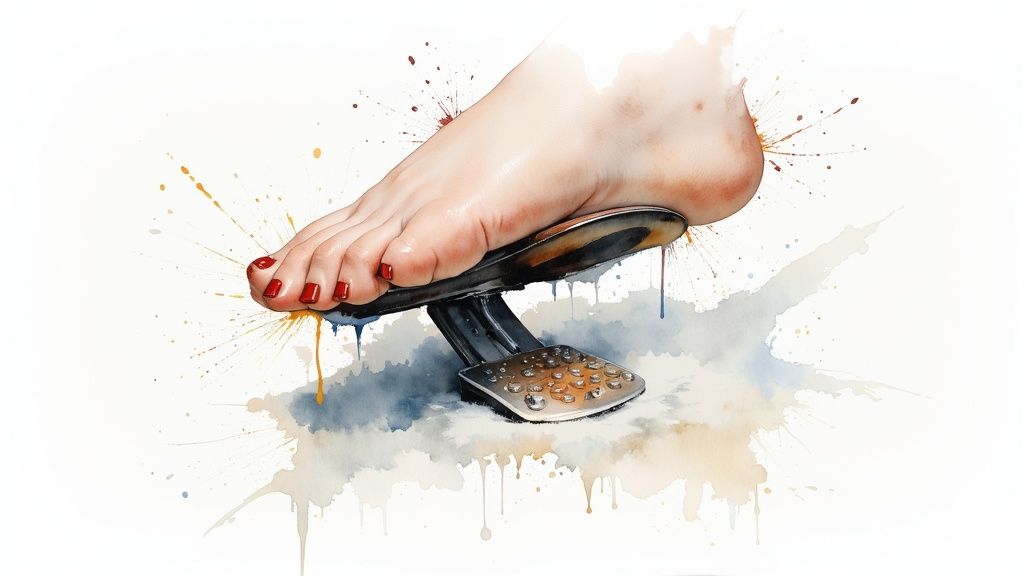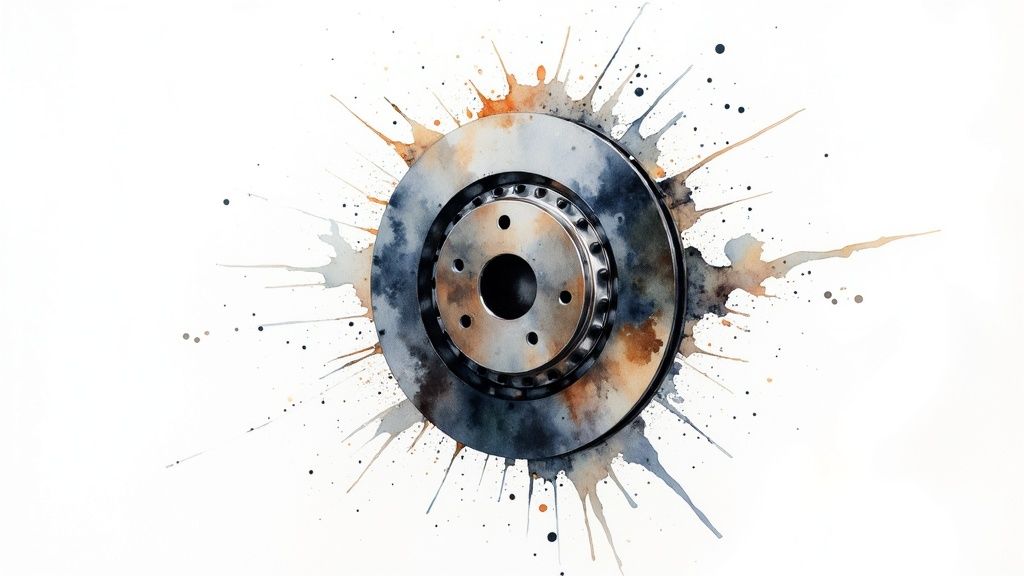Understanding Your Brakes: Essential for Safe Driving
Your brakes are crucial for safety. This listicle details six common brake problem symptoms so you can address issues quickly and efficiently. Recognizing these signs early prevents accidents and costly repairs. Learn to identify a squealing or grinding noise, soft brake pedal, pulling to one side, brake pedal vibration, a burning smell, and increased stopping distance. These symptoms indicate potential brake problems that shouldn't be ignored. If you live near Haltom City, Keller, Watauga, or North Richland Hills, TX, and experience any of these, visit Express Lube & Car Care for expert brake inspections and service.
1. Squealing or Grinding Noise When Braking
One of the most common and easily recognizable brake problem symptoms is a high-pitched squealing or a harsh grinding noise when you apply the brakes. This is a key indicator of worn brake pads or rotors and should never be ignored. The squealing sound often originates from a small metal tab called a wear indicator, designed to contact the rotor when the brake pad material gets too low. This acts as an early warning system, alerting you to the need for brake service. Grinding noises, however, signify more severe wear, indicating that metal components are grinding directly against each other. This can lead to significant damage if not addressed immediately. This symptom deserves its place high on the list because it is often the first and most noticeable sign of brake trouble.

Features of this Brake Problem Symptom:
- High-pitched squealing or harsh metallic grinding: The sound can vary depending on the severity of wear.
- Noise typically increases with brake pressure: Applying more pressure to the brakes usually intensifies the noise.
- May be more noticeable at certain speeds: The noise might be more prominent at lower or higher speeds.
- Often most audible when braking from higher speeds: The increased friction at higher speeds can make the noise more apparent.
Pros of Early Detection:
- Early warning system: The squealing acts as a built-in alert system, giving you time to schedule maintenance.
- Easy to identify: No special tools are needed to recognize the noise.
- Prevents complete brake failure: Addressing the issue early prevents further damage and potential safety hazards.
Cons and Considerations:
- Extensive damage with grinding: By the time grinding occurs, significant damage may have already occurred to the rotors.
- Weather-related noise: Sometimes moisture, particularly in the morning, can cause temporary brake noise that isn't indicative of a problem.
- Aftermarket pad noise: Aftermarket brake pads can have different noise characteristics than original equipment manufacturer (OEM) pads.
Examples of Squealing or Grinding Brakes:
- A Honda Civic with worn front brake pads will typically produce a squealing noise during the last 2,000-3,000 miles of pad life.
- BMW vehicles often use electronic wear sensors instead of metal tabs. These sensors illuminate a dashboard warning light when the brake pads are worn, rather than making a noise.
Actionable Tips for Drivers in Haltom City, Keller, Watauga, and North Richland Hills, TX:
- Don't ignore brake noises: Even intermittent squealing should be investigated by a qualified technician.
- Seek immediate service for grinding: Grinding noises require immediate attention to prevent further rotor damage. Contact a trusted local auto service provider like Express Lube in Haltom City.
- High-performance pads: Be aware that some high-performance brake pads can produce more noise than standard pads, even when they are in good condition.
Learn more about Squealing or Grinding Noise When Braking This link provides valuable information on brake pad replacement and can help you understand the importance of addressing brake noise promptly. For those of you in the DFW area, especially Haltom City, Keller, Watauga, and North Richland Hills, this resource is particularly relevant. Whether you're a busy professional, fleet manager, or simply a safety-conscious driver, understanding brake problem symptoms like squealing and grinding is crucial for maintaining your vehicle and ensuring safe driving conditions.
2. Soft or Spongy Brake Pedal
A soft or spongy brake pedal is a serious brake problem symptom that should never be ignored. Instead of feeling firm and resistant, the pedal feels soft, mushy, or like you're pushing a sponge. It may even slowly sink to the floor when you hold pressure on it. This disconcerting feeling indicates a problem with your vehicle's hydraulic braking system, which is responsible for transferring the force from your foot to the brakes at each wheel. This softness signifies a loss of hydraulic pressure, which is crucial for effective braking. This pressure loss reduces braking effectiveness, increasing stopping distances and creating a dangerous situation for you and other drivers.

This compromised hydraulic pressure can stem from several issues, most commonly air in the brake lines, a failing master cylinder, or a brake fluid leak. Air in the lines compresses under pressure, preventing the full force from reaching the brakes. A malfunctioning master cylinder, the heart of the hydraulic system, can't effectively build or maintain the necessary pressure. Lastly, a leak anywhere in the system, from the lines to the wheel cylinders or calipers, will result in pressure loss. This symptom deserves a prominent place on the list of brake problems because it directly impacts your ability to stop safely.
Features of a spongy brake pedal problem include a pedal that feels soft or lacks resistance, a pedal that may slowly sink to the floor when held down, increased braking distance, and the need to pump the brakes to build pressure. While a noticeable change in pedal feel is a clear indicator and the gradual worsening often allows time to address the issue, it can be dangerous because it indicates a potentially serious hydraulic system issue that may lead to complete brake failure if not addressed. The change can also be subtle if it deteriorates slowly, making it difficult to distinguish from the normal pedal feel. In emergency situations, pumping the brakes can sometimes temporarily improve braking performance, but this is not a long-term solution.
For example, certain Toyota Camry models have been known to experience master cylinder issues leading to soft pedals, while Ford F-150 trucks, particularly in salt-belt states like those impacting drivers in Keller, TX, Watauga, TX, North Richland Hills, TX, and the greater Haltom City area, sometimes develop brake line corrosion leading to fluid leaks and spongy pedals. Learn more about Soft or Spongy Brake Pedal for further information and potential solutions.
If you experience a soft or spongy brake pedal, it's crucial to take immediate action. First, check your brake fluid level. A low level often points to a leak. Next, inspect for visible leaks around the wheels and under the master cylinder. Never drive a vehicle with a spongy brake pedal. Have it towed to a qualified mechanic for diagnosis and repair. If air in the lines is the culprit, bleeding the brakes might resolve the problem. For drivers in Haltom City, especially busy professionals, fleet managers, and safety-conscious individuals seeking reliable service from certified technicians, this issue should be addressed promptly. Remember, a functioning brake system is paramount for your safety and the safety of others on the road.
3. Vehicle Pulls to One Side When Braking
One of the most noticeable and concerning brake problem symptoms is when your vehicle pulls to one side while braking. This indicates an imbalance in braking force between the left and right wheels. Instead of stopping in a straight line, the car veers left or right, creating a dangerous and unpredictable situation, especially in emergency stops. Understanding this symptom is crucial for maintaining safe driving conditions and preventing further damage to your vehicle.

This pulling sensation can range from a slight drift to a severe jerk, depending on the underlying cause. Several factors can contribute to this uneven braking, including a stuck brake caliper, contaminated brake pads, uneven brake pad wear, a collapsed brake hose, or even, in some cases, alignment issues. The pull is consistently in the same direction, which is an important diagnostic clue. It’s also worth noting that the pull may only be noticeable during harder braking.
This symptom warrants its place on this list because it directly impacts safety and control of the vehicle. Ignoring a pulling vehicle can lead to more serious and costly repairs down the line.
Features and Benefits of Early Diagnosis:
- Easy Initial Diagnosis: A visual inspection can often reveal discrepancies between the left and right brakes, like uneven rotor wear or leaking brake fluid.
- Predictive Location: The direction of the pull often indicates a problem on the opposite side. For instance, pulling to the left often suggests an issue with the right-side brakes.
- Potential for Simple Fix: In some cases, simple maintenance like cleaning or lubricating caliper slide pins can resolve the issue.
Pros:
- Relatively easy to diagnose with a basic inspection.
- Often indicates the problematic side based on pull direction.
- Can sometimes be corrected with simple maintenance.
Cons:
- Creates unpredictable handling during emergencies.
- May be confused with alignment or tire pressure issues.
- Can cause uneven tire and brake wear if left unaddressed.
Examples:
- Chevrolet Silverado trucks are known to sometimes develop caliper slide pin issues that can cause pulling.
- Certain brake pad formulations used in Mazda vehicles can be susceptible to contamination, leading to uneven braking.
Actionable Tips for Drivers in Haltom City, Keller, Watauga, and North Richland Hills, TX:
- Visual Check: Look for obvious leaks or differences in rotor appearance between the left and right sides.
- Test Drive: Perform a gentle braking test from low speed in an empty parking lot to confirm the pull.
- Comprehensive Inspection: Even if the problem seems isolated to one side, have both sides inspected by a qualified technician.
- Tire Pressure Check: Ensure tire pressures are equal before diagnosing the problem as a brake issue. This is a simple check that can save you time and money.
For residents of Haltom City, Keller, Watauga, and North Richland Hills, TX, addressing this brake problem symptom quickly is crucial. Whether you're a busy professional, fleet manager, or simply a safety-conscious driver, neglecting this issue could compromise your safety and lead to more extensive repairs. Promptly addressing this issue ensures safe and reliable vehicle operation. Contact a trusted local mechanic for a professional brake inspection and service if you experience pulling while braking.
4. Brake Pedal Vibration or Pulsation
A pulsating or vibrating brake pedal, sometimes felt through the steering wheel, is a key brake problem symptom you shouldn't ignore. This often indicates warped brake rotors or drums. This warping occurs when the braking surface develops uneven thickness variations. These variations can stem from excessive heat buildup due to hard braking, improper tightening (torquing) during brake installation, or extended periods of heavy braking, such as when towing heavy loads or driving in mountainous terrain. As the uneven rotor or drum surface passes through the brake pads, it creates a pulsing sensation that transmits through the hydraulic system to the brake pedal.

This pulsing or vibrating sensation in the brake pedal is a clear and distinguishable symptom, setting it apart from other brake issues. The pulsation often becomes more noticeable at higher speeds, and its frequency increases with vehicle speed. If the vibration is also felt in the steering wheel, it typically points to warped front rotors. This symptom usually develops gradually, giving you time to address the issue before it escalates. Furthermore, while uncomfortable, warped rotors rarely lead to complete brake failure, providing a window of opportunity for repair.
For instance, BMW 3-series models, known for their sporty handling and often driven aggressively, are more prone to developing warped rotors. Similarly, heavy-duty trucks like Ford Super Duty models can experience rotor warping after towing heavy loads, especially in the mountainous terrain around Keller, TX, Watauga, TX, North Richland Hills, TX, and other areas near Haltom City.
While a pulsing brake pedal is a clear indicator of a problem, it does have some drawbacks. Repairing warped rotors can be expensive if they require replacement rather than resurfacing. Also, if the underlying cause of the warping, such as aggressive driving habits or frequent heavy towing, isn't addressed, the problem may return quickly even after repair. Finally, the pronounced vibration can sometimes mask other underlying brake issues that might be developing simultaneously.
Actionable Tips for Addressing Brake Pedal Pulsation:
- Avoid abrupt stops after hard braking: If the vibration begins after your vehicle has been parked with hot brakes, it's a sign of potential warping. Try to avoid stopping immediately after periods of hard braking to allow the rotors to cool more evenly.
- Have rotors measured: A qualified technician can measure your rotors for thickness variation and runout to determine the extent of the warping.
- Consider rotor upgrades: If the problem recurs, consider upgrading to higher-quality rotors designed for better heat dissipation and durability.
- Ensure proper wheel torque: Make sure the correct wheel torque specification is followed during tire rotations and changes, as improper torquing can contribute to rotor warping.
This brake problem symptom deserves a place on this list due to its clear indication of a specific issue – warped rotors or drums. It's a symptom easily recognized by drivers and, while potentially costly to repair, rarely results in immediate brake failure. By being aware of this symptom and understanding its causes and implications, drivers in Haltom City and the surrounding areas can address the problem proactively and ensure their safety on the road. For those seeking professional brake inspections and repairs, Learn more about Brake Pedal Vibration or Pulsation or consult with a trusted mechanic in your area. Companies like StopTech, Power Stop, and EBC Brakes are popular resources for high-quality brake components and information.
5. Burning Smell While Driving
One of the most alarming and readily identifiable brake problem symptoms is a burning smell while driving. This distinct, acrid, often chemical-like odor indicates excessive heat buildup within your braking system. Understanding this symptom is crucial for preventing further damage and ensuring your safety on the road. This symptom deserves its place on this list because it's a potent warning sign that often presents itself before complete brake failure.
What Causes the Burning Smell?
The burning smell emanates from overheated brake components. Several issues can lead to this overheating:
- Stuck Caliper: A caliper is a hydraulic clamp that squeezes the brake pads against the rotor to stop your vehicle. If a caliper gets stuck, even partially engaged, it creates constant friction and heat.
- Dragging Brake Pads: Similar to a stuck caliper, brake pads that don't fully retract after you release the brake pedal will continuously rub against the rotor, generating heat and that telltale burning smell.
- Seized Parking Brake Components: If your parking brake is engaged or components within the parking brake system are seized, it can lead to dragging and overheating, especially in the rear wheels.
- Aggressive or Constant Braking: Driving down a long, steep hill and constantly riding your brakes can also generate excessive heat. This is less of a mechanical problem and more a result of driving habits, but it can still lead to the same burning smell and potential damage.
Features of this Brake Problem Symptom:
- Sharp, acrid odor: The smell is often described as similar to burning chemicals.
- Smoke: In severe cases, you may see smoke emanating from the wheel area.
- Reduced braking performance: You might experience decreased braking power or a spongy brake pedal feel.
- Noticeable after intensive use: The burning smell is usually most potent immediately after stopping, particularly after heavy or prolonged brake use.
Pros of Recognizing this Symptom:
- Immediately noticeable: You don't need special tools or diagnostic equipment to detect the burning smell.
- Clear indicator of excessive heat: It's a strong signal that something is wrong with your braking system.
- Early warning: Often, the burning smell appears before catastrophic brake failure, giving you time to address the issue.
Cons of this Symptom:
- Multiple potential causes: Pinpointing the exact problem requires further diagnosis.
- Potential for existing damage: By the time you notice the smell, some damage may have already occurred.
- Possible confusion with other smells: Similar burning smells can sometimes originate from the clutch or transmission.
Examples:
- Some Subaru models have been known to experience parking brake issues that lead to dragging and burning smells.
- Certain Jeep Grand Cherokee models have had problems with calipers sticking, causing excessive heat and the associated burning smell.
Actionable Tips:
- Pull over safely: If you notice a burning smell, pull over immediately and allow the brakes to cool.
- Check for heat (with caution): Carefully check all four wheels for excessive heat. The wheel closest to the source of the burning smell will likely be the hottest. Be extremely cautious, as overheated brake components can cause burns.
- Avoid riding the brakes: On long downhills, use engine braking to help control your speed and reduce strain on your brakes.
- Tow if necessary: If the smell is strong or accompanied by smoke, have your vehicle towed to a qualified mechanic.
This symptom warrants prompt attention. For residents of Haltom City, Keller, Watauga, and North Richland Hills, TX, experiencing this or any other brake problem symptoms, seeking professional brake inspection and service is crucial. Don't hesitate to contact a trusted mechanic to diagnose and repair the issue, ensuring your safety and preventing further damage to your vehicle's braking system. Remember, ignoring this symptom can lead to costly repairs and potentially dangerous driving conditions.
6. Increased Stopping Distance
Increased stopping distance is a serious brake problem symptom that should never be ignored. This means your vehicle requires significantly more distance to come to a complete stop than it usually does, signaling a reduction in braking efficiency. This dangerous symptom may not be immediately obvious in everyday driving, potentially leading to hazardous situations when a sudden stop becomes necessary. This is why diligent attention to your vehicle's braking performance and understanding this symptom is crucial for safe driving in Haltom City, Keller, Watauga, North Richland Hills, and surrounding areas.
How it Works (and Fails):
Your vehicle's braking system is a complex network of components working together to convert the force you apply to the brake pedal into the friction needed to slow and stop your wheels. Increased stopping distance indicates a breakdown somewhere within this system. It could stem from worn brake pads or shoes, which provide the friction material against the rotors or drums. The friction material itself can become glazed, reducing its effectiveness. Problems within the hydraulic system, including low or contaminated brake fluid, a malfunctioning master cylinder, or even issues with the power brake booster (which amplifies your pedal force), can also contribute to increased stopping distances.
Features and Why it Deserves its Place on the List:
- Vehicle takes longer to stop than normal: This is the primary indicator and the reason this symptom is so critical for safety.
- Brake pedal may require more force: You might notice you're having to push the brake pedal down further or harder to achieve the same braking effect.
- May worsen gradually over time: Often, this issue develops slowly, making it difficult to notice until it becomes significant. Regular checks can prevent this from escalating.
- Often most noticeable during higher-speed braking: While present at all speeds, the increased stopping distance becomes more pronounced and dangerous at higher speeds.
This symptom earns its place on the list due to its direct impact on safety. A vehicle that cannot stop efficiently poses a severe risk to the driver, passengers, and other road users.
Pros and Cons:
- Pros: Can sometimes be detected during routine driving, May prompt preventative maintenance, Often correctable with standard brake service.
- Cons: Can be difficult to self-diagnose without comparison, May only become apparent in dangerous situations, Drivers often compensate unconsciously until the situation becomes severe.
Examples:
Certain vehicle models are more prone to specific brake issues. For instance, some Honda CR-V models have been known to experience brake booster issues leading to increased pedal effort and longer stopping distances. Some generations of the Toyota Prius have had reported brake feel issues related to the integration of the regenerative braking system. While these are specific examples, any vehicle can experience increased stopping distance due to various brake problems.
Actionable Tips:
- Periodically test brakes in a safe, empty area: Find a safe location, like an empty parking lot, to check your braking distance. Get a feel for how your brakes normally perform.
- Be especially vigilant after brake service or tire changes: Ensure the work has been performed correctly and your braking system functions as expected.
- Consider professional brake testing if you suspect issues: A qualified mechanic can diagnose and address any underlying problems. Don't hesitate to bring your vehicle to a trusted auto repair shop in Haltom City, Keller, Watauga, or North Richland Hills if you notice anything unusual.
- Take note if you're pressing the brake pedal further than usual: This can be an early warning sign of developing brake problems.
Popularized By:
Information about this crucial safety issue is widely disseminated by organizations like the National Highway Traffic Safety Administration (NHTSA) through safety campaigns. Performance brake manufacturers like Hawk Performance and Pagid Racing also emphasize the importance of proper braking performance.
When you suspect any issues with your brakes, don't hesitate to seek professional help. Your safety and the safety of others on the road depend on a properly functioning brake system. We encourage drivers in Haltom City, Keller, Watauga, North Richland Hills, TX, and surrounding areas to prioritize regular brake inspections and maintenance.
Brake Issue Symptoms Comparison
| Symptom | 🔄 Implementation Complexity | 💡 Resource Requirements | 📊 Expected Outcomes | ⚡ Ideal Use Cases | ⭐ Key Advantages |
|---|---|---|---|---|---|
| Squealing or Grinding Noise When Braking | Low – Audible symptom, easy to identify | Minimal – No special tools needed | Early wear detection; potential for costly damage if ignored | Routine brake wear monitoring | Early warning; easy detection without tools |
| Soft or Spongy Brake Pedal | Medium – Requires inspection & hydraulic check | Moderate – Fluid inspection, possible bleeding or repairs | Reduced braking efficiency; possible brake failure if untreated | Diagnosing hydraulic/brake fluid issues | Clearly noticeable; gradual worsening allows response |
| Vehicle Pulls to One Side When Braking | Medium – Diagnostic testing required | Moderate – Inspection of calipers, hoses, alignment | Uneven braking force; unsafe handling | Identifying uneven brake force or alignment problems | Relatively easy to diagnose; can prevent uneven wear |
| Brake Pedal Vibration or Pulsation | Medium-High – Rotor measurement & possible replacement | Moderate-High – Tools for rotor check and potential rotor replacement | Pulsating brake feel; can affect steering control | Warped rotor detection after heavy use or overheating | Clearly distinguishable; gradual development |
| Burning Smell While Driving | Low – Sensory symptom, urgent attention needed | Low-Moderate – Inspection for overheating components | Brake overheating; risk of brake fade or damage | Detecting overheating due to stuck pads or calipers | Immediate and clear warning; prevents catastrophic issues |
| Increased Stopping Distance | Medium – Requires performance testing and inspection | Moderate – Brake system inspection and possible repairs | Reduced braking power; longer safe stopping distance | Monitoring overall brake system efficiency | Can detect failing brakes before emergencies |
Don't Wait for Brake Trouble: Schedule a Checkup Today!
From squealing and grinding to a soft brake pedal or that unsettling pull to one side, recognizing brake problem symptoms is crucial for your safety and the longevity of your vehicle. We've covered six common indicators of brake issues: squealing or grinding noises, a spongy brake pedal, pulling to one side while braking, brake pedal vibration, a burning smell, and increased stopping distance. Ignoring these signs can lead to more extensive and costly repairs down the line. If you're experiencing any of these symptoms, it's crucial to address them promptly. For a more comprehensive guide on identifying brake issues, check out this helpful resource: 8 Signs of Bad Brakes from Kwik Kar Oil Change and Auto Care. Mastering the ability to recognize these symptoms empowers you to take proactive steps, ensuring your safety and preventing potentially dangerous situations on the road. Remember, maintaining your brakes isn’t just about avoiding costly repairs; it's about protecting yourself, your passengers, and other drivers on the road in Haltom City, Keller, Watauga, and North Richland Hills, TX.
Don't compromise when it comes to your brakes. Experiencing any of these brake problem symptoms? Express Lube and Car Care in Haltom City offers fast, reliable brake service from routine inspections to major repairs, ensuring your vehicle’s safety and optimal performance. Schedule an appointment today and get back on the road with confidence.





